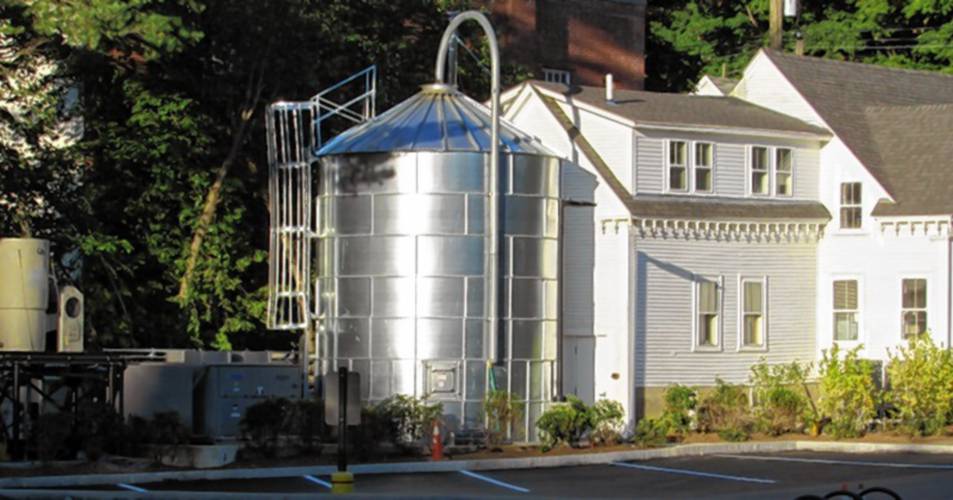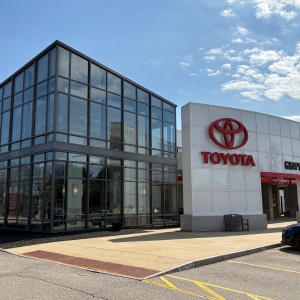Granite Geek: Burning wood to cool down the library. Yes, cool it.

The wood chip silo at the Peterborough Town Library Courtesy of Froling Energy
|
Published: 07-08-2024 12:17 PM
Modified: 07-08-2024 6:05 PM |
Setting fire to wood is a great way to stay warm, which is why human beings have been doing it ever since we became human beings, but to my surprise there’s a place in New Hampshire where it’s used to stay cool.
“It has been working great,” said Corinne Chronopoulos, director of the Peterborough Town Library.
As part of a $3 million renovation completed in 2021, the library dumped its forced hot air system fueled by an oil-fired boiler and replaced it with an absorption chiller that burns wood chips. It heats water to make things warm in the winter but in summer makes cool water that gets piped into the building.
The idea of chilling water by burning wood seemed wrong to me in all sorts of ways until I remembered air conditioners. They use electricity to make cold air by compressing and expanding fluid under pressure, and electricity is sort of like burning wood if you don’t think about it too hard.
The library’s chip boiler, which has been operating almost two years, generates 190-degree water stored in a 600-gallon buffer tank. When cooling is required, hot water from the buffer tank is circulated through an absorption unit that uses it to remove heat from separate water supply that, once chilled, is sent into the library. (To see the details, check out www.yazakienergy.com/waterfired.htm)
From the outside there’s one telltale sign of this system: a 42-ton silo that holds wood chips. Otherwise, said Chronopoulos, “I don’t think the public is widely aware of it.”
Peterborough’s system is made by Yazaki Energy Systems, a subsidiary of a Japanese company whose main business is automotive parts. Aside from using wood chips as a power source, its big claim to fame is that it uses a solution of lithium bromide, a non-toxic salt, and water as its refrigerant rather than anything that can harm the environment.
So far as I can tell, this is the only one in New Hampshire. It’s certainly the only one installed by Froling Energy of Keene.
Article continues after...
Yesterday's Most Read Articles
 New Hampshire State Police join ICE task force
New Hampshire State Police join ICE task force
 ‘It’s always there’: 50 years after Vietnam War’s end, a Concord veteran recalls his work to honor it
‘It’s always there’: 50 years after Vietnam War’s end, a Concord veteran recalls his work to honor it
 Facing 30% budget cut, university leaders say raising tuition is not an option
Facing 30% budget cut, university leaders say raising tuition is not an option
 25-year-old man shot by police in Keene, AG investigating
25-year-old man shot by police in Keene, AG investigating
 Two of five Grappone auto franchises to be sold as part of family transition
Two of five Grappone auto franchises to be sold as part of family transition
 ‘Anger and backlash’ – Allenstown residents frustrated over elimination trash services
‘Anger and backlash’ – Allenstown residents frustrated over elimination trash services
“It’s an old technology, actually. Industry uses these sorts of things for various purposes. … This method is modern, more controlled,” said Jim Van Valkenburgh, VP of marketing and sales for Froling.
“It’s expensive to put in, especially if you need a full redundant backup,” he said. This system covers about 70% of the library’s cooling needs, so a traditional air conditioner is also needed.
The circumstances of the upgrade, which expanded and rebuilt much of the old building – Peterborough has the oldest free tax-supported public library in the nation, dating back to a meeting in 1833 – made this system more financially feasible. A $300,000 grant to help get buildings off fossil fuels was a deciding factor as well.
“Because they put in the wood boiler for heating, it makes sense to add this. You’re not going to use that boiler all summer long, might as well get this out of it,” Van Valkenburgh said.
Importantly, the rehabilitation project tightened up the entire library, reducing leaks. Any good contractor will tell you that it’s dumb to upgrade a heating or cooling system without first making sure the building isn’t going to waste the energy you’re paying for.
Chronopoulos said one reason the library board went with this system is environmental: “One of the principles is to be as sustainable as possible.”
However, burning wood for heat or electricity isn’t a slam dunk from the environmental point of view; it still involves burning something and releasing greenhouse gases. The question is whether it’s sufficiently better than doing the same thing with fuel oil or methane gas. There’s no definite answer, and long-term readers will know I’ve gone back and forth on the topic.
At the very least, using wood as heat is a bonus for the region’s economy. We’ve got a lot of forests and a lot of people working in those forests who need clients.
This system’s heat pump function is intriguing. Electric heat pumps are, as you probably know, one of the most powerful tools in the climate fight. They’re much more efficient than burning fuels when it comes to heating and are equivalent to electric air conditioners, which are just one-way heat pumps for cooling.
Swapping out oil/gas systems heating for electric heat pumps is always an environmental win. For most buildings, including my house, they’re the way to go rather than a wood-burning chiller. But it’s neat to know that something as non-intuitive as “let’s burn wood to cool this building” exists.







 ‘A full board’: After frustration, Chichester appoints a third selectman
‘A full board’: After frustration, Chichester appoints a third selectman Patriot Piecemakers craft quilts to honor veterans
Patriot Piecemakers craft quilts to honor veterans From raising chickens to programming a VR game, Merrimack Valley High School students show off their senior projects
From raising chickens to programming a VR game, Merrimack Valley High School students show off their senior projects Baseball: Slow night at the plate costs Concord in loss to Windham, 3-1
Baseball: Slow night at the plate costs Concord in loss to Windham, 3-1
